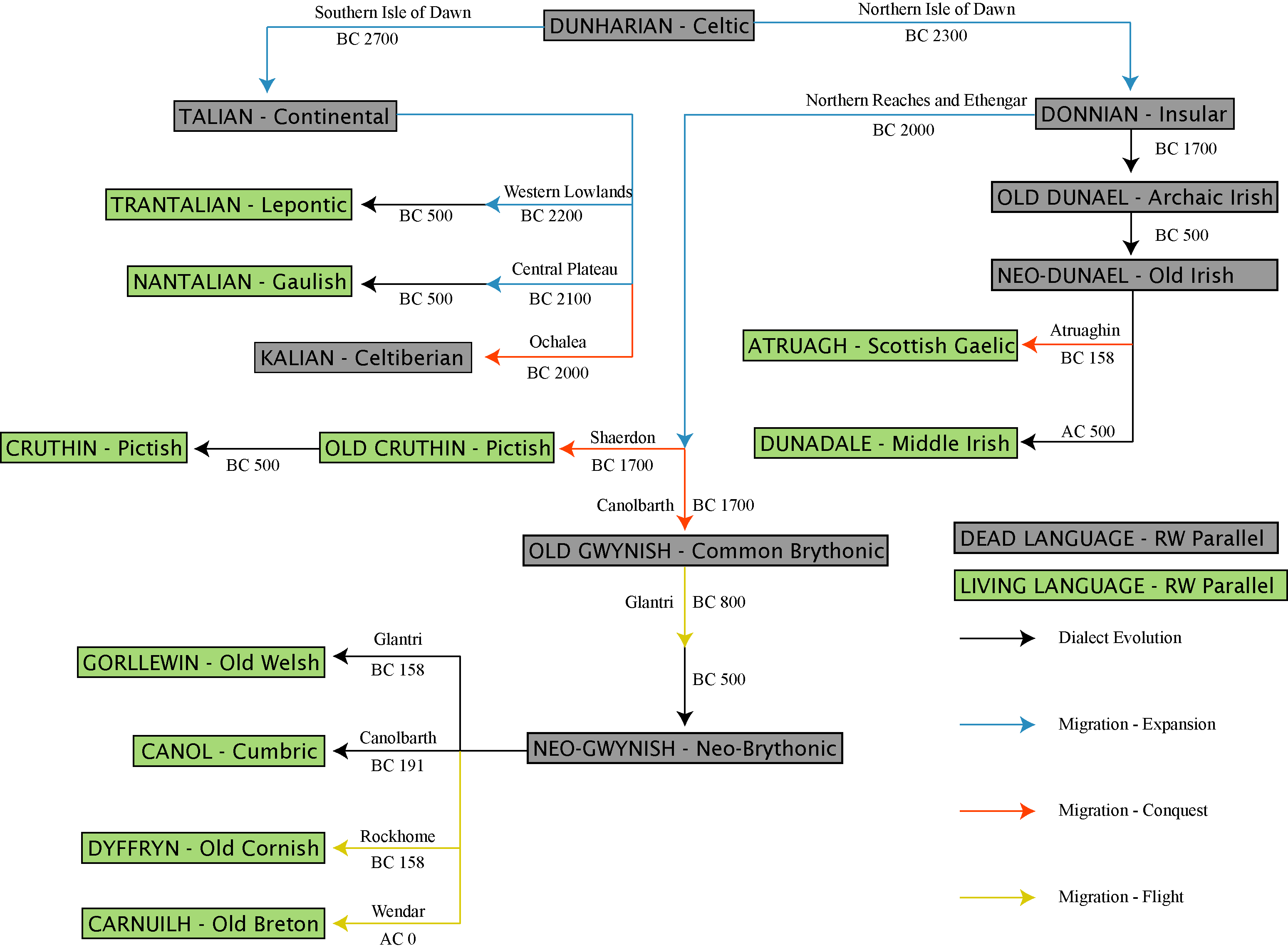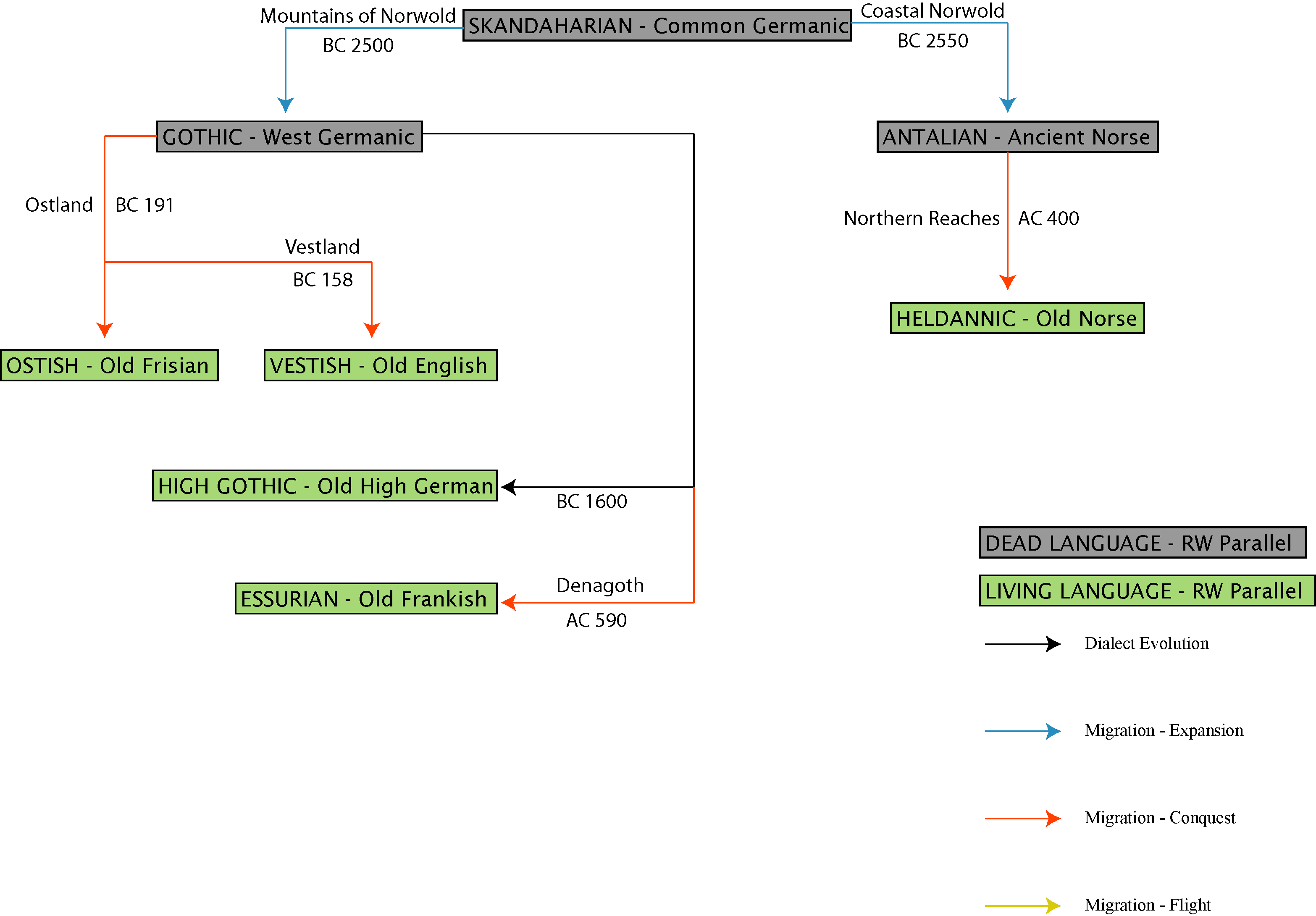
The Known World of Dracopolis: languages and history of the Dunharian people
by Lance DuncanJust put up a blog post about the languages and history of the Dunharian people in my campaign. I'll reproduce the text below
Immediately after the GRoF (keep in mind Blackmoor is in the Broken Lands in my Known World) the Dunharians were situated on the Isle of Dawn. During the Dark Ages following the disaster the Dunharians split into many rival tribes to the extent that they no longer saw themselves as the same people. These divisions resulted in two major groups, the Donn(so called because of their brown clothes) of the north and the Tal of the south.
The Talians
The Tal fought many minor wars and fought off many invasions of the various peoples of the mainland to the west. This eventually led to a mingling of cultures and language that separated the people on the western coast from those that had moved up into the central plateau. Over time the upland Nantalians were influenced by the Nithian descended Thothians on the west coast, yet over the centuries they have maintained a distinct cultural identity that harks back to their Dunharian roots.
While the Nantalians were isolated by the plateau, the coastal Trantalians became civilized on the model of their neighbors to the west founding city-states and engaging in trade and diplomacy. Though having a different culture and language, a typical Trantalian city would be virtually indistinguishable from a Doulakki city to the west. Through the centuries, the empires of the west(Nithian, Thang, Thyatian) have always found it more useful to establish favorable trade deals and make allies with some of the more powerful Trantalian kingdoms or cities than to directly subjugate them.
While the Tal were still warring with the people of the western continent, one tribe fled the Isle of Dawn and settled in the island to the south (Ochalea). Over a short period of time this tribe, the Kallians, either conquered or assimilated most of the indigenous population of the island. A few centuries later when the great flood sunk Taymora, a group of refugees fled to this island and called it Ochalea after the civilized people they encountered there. The two groups inhabited the island together for many centuries until the Thang Empire conquered it. During the the following centuries, the Thang language and culture came to dominate the island, though the people always retained some traits that spoke of their unique heritage.
The Donnians
Meanwhile, to the north the vast majority of the Donn left the isle of Dawn on a mass migration across the landbridge to the mainland(modern day Ethengar and the Northern Reaches); they became the Gwynish people and will be discussed below. The Donn who stayed behind were few in number and for many centuries their society remained tribal and simple. After the great flood which severed thier connection to the mainland, the Donn people became divided and many petty kingdoms rose up; these became known as the Dunael kingdoms. Over the centuries the great empires dealt with these northern kingdoms in the same manner as they did the southern Trantalian cities.
Toward the decline of the Thang Empire, they often hired 'barbarian' mercenaries to fight their wars for them, and the the Dunael were considered some of the most reliable and ferocious warriors in the armies of the empire. Thus it happened that a Dunael captain, known as Atruaghin, became a great hero to both the Thang Empire and the Dunael people. Due to his great deeds for the empire, after his death Atruaghin's followers were given land in the western marches of the empire to settle. The people of Atruaghin keep their traditions alive and were some of the first to convert to the true faith of The Church.
After centuries of division and outside powers influencing the wars and politics of the Dunael kingdoms, the vast majority formed the Dunadale Confederacy. Since the formation of the Confederacy, the Dunael people have had more independence, prosperity, and growth than ever before. Dunadale has become the preferred name of the people and their language in a show of loyalty to the Confederacy.
The Gwynish
After the GRoF the Great Bay north of Blackmoor emptied and became an expansive plain, also a land bridge was formed between the Isle of Dawn and the Northern Reaches. After the worst effects of the GRoF had dissipated and these new lands became viable for agriculture, a great flood of people spread into these new lands. For a time these people and the Donnian of the Isle of Dawn remained one and united. However, after the great floods sunk both Taymora and the land bridge the Dunael people of the continent were separated from those on the Isle of Dawn. Those on the continent, seeing the weakness of their neighbors, went on another great migration, this time one of conquest. They passed over the mountains and flooded into the Canolbarth plains(there was no forest at that time) slaughtering the inhabitants who had just suffered catastrophe during the quakes floods that had destroyed Taymora.
Many settled the Canolbarth plains, while others continued on to the southern coast over the Cruth mountains. Those who continued to the coast slaughtered any remaining Taymorans and enslaved the native population of elves they found there. These tribes became isolated, developing their own idiosyncrasies, and became known as the Cruthin. Only a few centuries later the great Hin migration arrived at the shores of the Cruthin. Caught unprepared, the Cruthin were slaughtered and driven into the mountains. To this day a few Cruthin tribesmen can be found in areas considered uninhabitable by civilized folk. These 'wild men' follow their ancient traditions and have never converted to the ways of the one true Church.
Following the great flood and subsequent conquest of the Canolbarth, the Donn people of the continent, though isolated from their cousins on the Isle of Dawn, shared a single culture and language which unified them. This united people, across Canolbarth, Ethengar, and the Northern Reaches, became known as the Gwynish. The Gwynish tribes flourished for several centuries unchallenged. this was not to last however, as first the Nithians from the east, and then the Thang from the west, built expansive empires and conquered the neighboring gwynish tribes; eventually the Nithians were defeated by the Thang and all the Gwynish became subject to a single empire.
During this period of conflict between the Nithian and Thang Empires, a tribe of elves came to the Thang empire with an offer of an alliance. With the help of the elves, the Thang drove the Gwynish who had allied themselves with the Nithians out of the Canolbarth plains. The elves were given this now 'empty' land and cultivated a dense forest there. The Gwynish who were driven out of the Canolbarth fled north to their free cousins in modern day Ethengar. The refugees along with the bravest of the Gwynish in Ethengar headed to the snow covered peaks of the west and settled among the river valleys of Glantri. Eventually they too were conquered by the Thang Empire.
During the decline of the empire, the northern frontier was abandoned to focus on threats from the west and south, and Imperial control was never reestablished over the region. A decade later 'barbarians' invaded the Gwynish provinces from the west. The Gwynish called on the empire for aid to no avail. In response to the plight of the Gwynish, a renowned warrior of the Dunael, named Atraughin, gathered an army and sailed across the sea to deliver his cousins. Once there all the warriors of the Gwynish united behind his banner and in a great battle drove off the invaders. Atruaghin was crowned King of the Gwynish and he built a great capitol city, Corunglain. He ruled for many years in peace and justice. He made an alliance with the Thang Empire and acted as the prime defender of both his realm and the empire, driving off several 'barbarian' hordes. He died in battle against an army of Gothic invaders from the north and his kingdom collapsed after his death
As noted above, his Dunael followers were settled by the Thang Empire to guard its western borders and became the Atruaghin Clans.
The Gwynish of the Northern reaches were slaughtered, driven off, or enslaved by the Gothic invaders who settled in their lands. The Gwynish who survived fled into the mountains and settled in the valleys of rockhome. These became the Dyffryn and are peaceful farmers and shepherds mostly who provide the mountain gnomes with food in return for protection.
The Gwynish of the western mountain valleys in modern Glantri devolved into feuding petty kingdoms. Isolated among the river valleys they developed their own dialect and became known as the Gorllewin Kingdoms. To this day they have maintained their independence from any foreign power and the old traditions of their ancestors. After many centuries a new group, worshippers of the sacred flame, came to the Gorllewin kingdoms. Their were many wars that followed, but that is a story for another time. Suffice it to say that the wars resulted in the isolation of these newcomers, known as Flaem, to the magical city of Glantri.
The Gwynish Kingdom survived for another century and a half, however, with the limited territory of Corunglain and modern Ethengar. The kingdom falls to a tribe of western 'barbarians' in the same year as the Thang Empire is conquered by those selfsame barbarians. The Gwynish of Ethengar are slaughtered or enslaved, but a significant portion of the population is able to flee to the north. They reached the land of Wendar safely and built a new society there in harmony with the elves. They now call themselves the Carnuilh.
There remain a remnant of the Gwynish people in the lands of the modern Holy Empire. there is a significant population around in Corunglain, and most of the people living in the woodlands and hills surrounding the realm of Alfheim are of Gwynish descent. All these people speak the Canol dialect and are people of the Canolbarth. They live fairly rustic lives away from the big cities. Most have converted to the one true Church, but follow the traditions of the Church of Atruaghin, rather than the Church of Darokin.
and here is the Dunharian language/migration tree
and the Skandaharian language tree. descriptions to follow, maybe later today....

